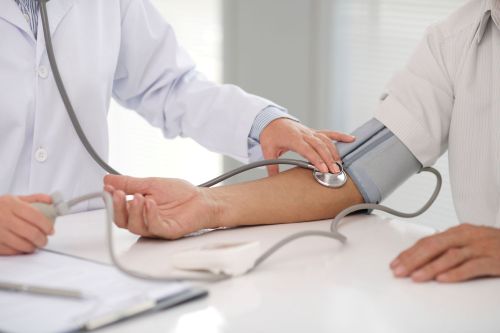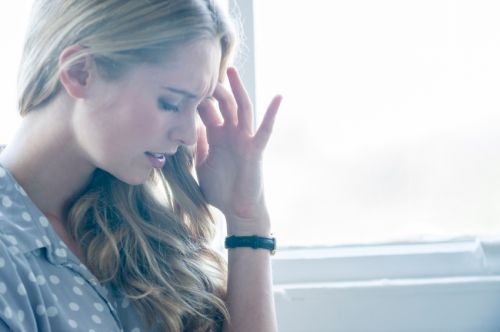Social phobia is one of the most common anxiety disorders in the western world. On average, 13 percent of people will develop it in their lifetime. The numerous symptoms are often underestimated, because there is more to the social phobia than just extreme shyness.
- People with social phobia are terrified of embarrassing themselves.
- © iStock.com/triocean
Social phobias, also known as anthropophobias, are often overlooked – probably because theirs Symptoms rash than extreme shyness is dismissed or overlaid by physical disorders. Most of the time those affected pull away in adolescence Social contacts back. They are terrified of being judged badly or of embarrassing situations.
Don't mistake social phobia as shyness
There is no precise information on the frequency (prevalence) of social phobia in Germany. According to the "National Comorbity Survey", in which data from 8,000 US citizens were evaluated, 15.5 percent of women and 11.1 percent of men will develop the social phobia during their lifetime.
Social phobics are hardly noticeable, are nice, friendly, but often withdrawn and avoid being the center of attention. You don't even see those who are worst affected: They hide themselves, avoid any contact with strangers.
Since that Clinical picture is not yet well known, many believe that they suffered from extreme shyness. However, if this shyness goes so far that those affected believe they are facing perceived threats Avoidance strategies If you need to protect yourself, you shouldn't ignore professional help. The chances of something new Self-confidence winning and participating in life again looks good.
What distinguishes social phobia from normal anxiety
Fear is a fundamental one feelingthat occurs in every human being just like joy, sadness and anger. It is part of everyone's everyday experience and can be experienced as a positive challenge. With a social phobia, on the other hand, your own stands or falls existence with what strangers or superiors think of you. "Social phobia starts where I get the anxiety and she can no longer overcome me in mine Restricts lifestyle", says Christa Roth-Sackenheim, chairwoman of the professional association of German psychiatrists.
The focus is always on the fear of being in front of others to embarrass and to be judged by them. Characteristic for Social phobics is a massive, irrational fear of contact with people or situations in which they could be carefully observed, critically assessed and negatively assessed. No question about it: for most people there are upcoming Confrontations or situations that are considered uncertain excitement, Fear, or at least malaise. The existence is not really endangered by it.
Symptoms of social phobia
A social phobia manifests itself in a number of ways. The unconsciously constantly present question "What does the other think about me?" leads to this in a social phobia internal pressureto want to meet supposedly high standards. This is especially true when it comes to contact and conversation with strangers, persons in authority, or with people who are assumed to be special or better.
Some operate according to the motto "Just don't attract attention" Gray mouse policy: sit in the back row, reject responsibility, are introverted, adapted, hardworking, work and live withdrawn. Elevate others perfectionism Regarding strategy: master the social rules, can communicate, adapt to others, appear sociable and are professionally successful. The facade is perfect, but fear always plays along.
Thoughts, feelings and beliefs of social phobics
The core aspect is the fear of emotional harm from others. The need for positive self-portrayal – and the doubt of making it – lead socially phobic people to the conviction that the situations that frighten them must end in embarrassment, rejection, humiliation, conflict and loss of status. They fear, for example
- Eye contacts
- appearing incompetent, stupid, and clumsy
- not liked, thought to be weird
- To talk nonsense, to have nothing interesting to say; to talk too much and for too long
- that others might discover the imaginary or actual weaknesses
- that others might think of them as inferiorly as they think of themselves
- not meeting one's own standards (social phobics are often their own harshest critics)
- your own physical reactions ("I am shaking, so I am incapable")
-

Hardly anyone is immune to crises. But while some are in danger of being broken by a stroke of fate, others will emerge stronger. Their secret is resilience.
go to Article
Against this background, it is not surprising that social phobics are often too Symptoms of Obsessive Compulsive Disorder have, for example, order, cleaning, control, thought constraints (in the sense of anticipating the negative reactions of others, resulting in incapacity to act).
Quite a few social phobics also try to cover up their fears with excuses, for example "I find parties boring", "I don't like people", "I sink into work".
Physical signs of a social phobia
Physiological reactions associated with a social phobia often occur days before threatening situations:
- blush
- Racing heart
- dry mouth
- sweat
- Tremble
- tense muscles
- Muscle twitching mostly in the face
- Stammering when speaking
- oppressive feelings in the chest
- Freeze
- Blackouts
- Difficulty following a conversation
- quick breath
- the feeling of being unable to breathe
- Urge to urinate
- nausea
- dizziness
- Fainting
- Sensations of heat or cold
The symptoms can increase so much that they take on the character of panic attacks.
Sexual dysfunction
Social phobias also manifest themselves in the form of sexual dysfunction. In women, for example, in loss of pleasure, pain during sexual intercourse, vaginal cramps; in men sometimes in absent or impaired erection, premature or delayed ejaculation. The fear of failing sexually or of not being attractive enough also prevents real closeness to the other. It is not uncommon for those affected to break off a beginning relationship on their own in order to forestall the frustrating feeling of being rejected by the other. Social phobics are often unmarried or live without a steady partner.
If symptoms of anxiety occur together with symptoms of depression and / or frequent use of alcohol / medication, you should definitely contact your doctor or a psychiatrist.
How does a social phobia arise? causes
Anyone who wants to understand social phobia has to unravel the close biological, psychological and biographical ties. As is so often the case, the confusion arises in childhood. Psychologists therefore warn against neglecting to attribute emotional problems in children and adolescents to development and puberty and not to take them seriously. So can
an overprotected childhood,
an upbringing lacking in loving care, appreciation and support,
traumatic experiences (physical, psychological abuse),
a style of upbringing that does not encourage self-confident and independent behavior,
Parents who do not support social contact with other families, who place excessive value on the opinion of others and who use shame as a method of discipline,
Feelings of guilt generated in upbringing (parents, kindergarten, school) as a method of discipline in the event of deviations from generally applicable norms
change important brain areas early on. The resulting biological scars shape the personality. Experts speak of increased fearfulness or vulnerability (vulnerability) to social situations that are experienced as threatening.
However, susceptibility alone does not necessarily lead to the disease. It is extremely important for people to be in a social community to be integrated while also being able to exercise a certain degree of social control. Fear and submissiveness occur especially when stressful situations, for example stressful living conditions or painful events, are experienced as uncontrollable. One therefore speaks of the vulnerability-stress model. This model integrates various currently valid explanatory approaches that are important for any anxiety disorder.
Internal and external stress lead to anxiety attacks
Those who have to cope with this kind of thing over and over again in the course of their development will sooner or later reach their limits. Adolescents generally have fewer opportunities to mentally defend themselves against stress and to cope with them.
Massive internal stress (e.g. changes in the equilibrium of the neurotransmitters in the brain, presumably especially in the system of the messenger substances serotonin and dopamine), in combination with external stress (e.g. separations, losses, exhaustion) lead to a overwhelming fear responsewhich itself creates fear.
One Vicious circle It happens when all attention is focused on the anxiety-inducing circumstance and tension rises due to the anxious expectation. The body does not differentiate whether it is a really existing danger or fear of anticipation. He activates that Alarm program just thinking about the situation. Decreasing self-confidence and skewed self-assessment eventually usher in Avoidance behavior. This reduces fear in the short term, but in the long term it is maintained by the lack of different experiences.
Social phobia diagnosed late or not diagnosed at all
People with a social phobia usually only see a doctor when physical complications get out of hand and a normal life is no longer possible. After all, they shy away from making contact with strangers.
Treatments for social phobia promise good results – if those affected overcome themselves and confide in the family doctor or a psychiatrist (a responsible family doctor will refer you anyway after the diagnosis has been clarified).
Step-by-step diagnosis
The professional search for a social phobia therefore makes sense in different steps.
1st conversation
The be-all and end-all for the first interview and all further conversations time. Accordingly, the initial interview takes a relatively long time. A conceivable introductory question is: "Do you have an unfounded strong fear of the present and the negative evaluation of other people, so that you avoid such situations or only get through them with great fear?" A positive answer suggests a social phobia.
-

Listening to the lungs, measuring blood pressure – these are basic examinations by the family doctor. But when does the X-ray take place and when do I, as a patient, have to go into the MRI tube?
To the picture gallery
The biography takes up a lot of space. The doctor asks specific questions about the family and partnership situation, about mental illnesses in the family. And: It gives the patient enough time to open up.
2. Assessment of various accompanying symptoms
In order to deepen the diagnosis, various accompanying symptoms are recorded and possible additional mental illnesses such as depression, alcohol or drug abuse are clarified. The assessment is based on the diagnostic criteria in the ICD-10 (International Classification of Diseases) and DSM-V (Diagnostic and Statistical Manual of Mental Disorders).
3. Physical and orientational neurological examinations
This includes:
EKG
Drawing of blood, which is examined in the laboratory mainly for hormonal disorders (e.g. hyperthyroidism)
EEG to rule out seizure disorders.
In cases of doubt, a cerebral computed tomogram or a magnetic resonance tomogram are also made
5. Psychometric methods
In addition to the various examinations, there is a whole series of psychometric methods. These are tests for assessing the psychological and intellectual performance that are based on the DSM-V and / or ICD-10 classification systems. With their help, the specialist can reliably find out in a relatively short time which anxiety disorder the patient is suffering from. Some examples:
DIPS: The diagnostic interview for mental disorders has established itself as a reliable diagnostic tool for various anxiety disorders. DIPS is also available for children and takes into account information from both parents and children.
SPS: The Social Phobia Scale researches the severity of fear of observing others and, like all of the following tests, is a questionnaire.
SIAS: The Social Interaction Anxiety Scale focuses on the ability to interact.
FNE: The Fear of Negative Evaluation Scale measures a wide range of shyness.
LSAS: The Liebowitz Social Anxiety Scale (social anxiety scale according to Liebowitz) records the severity of the social phobia and asks about avoidance behavior.
SPIN: In the Social Phobia Inventory (social phobia questionnaire), the patient is asked about the severity of fear in various social situations over the past week.
Good treatment prospects for social phobia
Social phobias can generally be treated well. Whether individual therapy or in a group, with or without medication – there are various therapy concepts that help Reduce fears. Which treatment is used depends not only on the personal framework, but also on the institute or the psychiatrist or psychotherapist.
Drug treatment for social phobia
Several systems of brain metabolism are involved in the fear response in the brain. Some are responsible for the quick (acute) fear reaction, others for the long-term willingness to respond with fear to a situation experienced as threatening. The aim of drug therapy is to influence these processes in such a way that stress and fear no longer overwhelm the patient in such an overwhelming and uncontrollable manner. So it is more than just taking medicines. The effectiveness and the associated progress of treatment must be checked regularly.
-

Noises, unpleasant smells, dealing with other people: highly sensitive people feel overwhelmed by them faster than others. They also?
Try it now
Only a few drugs have been studied specifically for the social phobia for possible effects, side effects and probability of success. Medicines that can be used are Antidepressants and tranquilizers.
Cognitive behavioral therapy
A central aspect of the treatment of fears is the comprehensive education about the disorder as well as about the course and structure of the therapy. Accordingly, she begins with detailed discussions with the therapist so that one first learns to understand the anxiety disorder. Then an adequate therapy package will be worked out together, which also takes into account the quality of life and psychosocial disabilities. In a sense, it belongs to the standard, socially anxious to be treated in a group. There are several interesting reasons for group therapy, such as the fact that those affected do not feel alone with their fear. Of course, there is also the option of individual therapy.
Most of the modern methods of reducing social anxiety originate from behavioral or cognitive behavioral therapy. It encompasses both cognitive (concerns attitudes, thoughts, self-talk, pictorial ideas, interpretations) and behavioral techniques. The basic assumption is that feelings and behaviors are a direct expression of thoughts. Hence, work is being done on irrational, unhealthy and problematic ways of thinkingassociated with mental health problems change.
In the case of social phobia, a psychotherapeutic treatment program is used, which takes place in several successive steps:
- Exposure therapy (or exposure therapy)
- Relaxation techniques
- Systematic desensitization
Confidence training
A central element of psychotherapy is the training of social skills. Quite a few social phobics had no opportunities in childhood or adolescence to acquire skills and behaviors in order to move appropriately in society. At the beginning of therapy, these sufferers first need special self-confidence and communication training for Learning social skills and social skills.
Cognitive restructuring
With the help of special exercises, cognitive patterns are checked and changed. A distorted self-perception – i.e. negative thoughts related to oneself, devaluing one's own achievements, fear of being devalued by other people, catastrophizing social situations in advance – is, in the opinion of many experts, an important factor in maintaining one's own insecurity. This takes place automatically Self-devaluation in turn has to do with information processing in the brain. With the help of special confrontation exercises, role plays and homework, these cognitive patterns are checked and changed. Patients learn that up to now they have attached more weight to their fearful fantasies than to reality. This learning process and the associated change in behavior ultimately improve self-image. The techniques and focuses are different.
Course of social phobia
Parents should pay attention if their children suddenly have stomach aches before each school day or if they no longer want to play with friends. Because social phobia can cause such problems. This anxiety disorder affects children and young adults in particular; studies estimate its frequency in this age group at five to ten percent. As a rule, however, extreme social fears can only be identified from the age of eight.
If the disease progresses well, the social phobia recedes with the onset of adulthood. With others it stays for a lifetime: because the social phobia is more likely to run chronic. However, the risk of relapse varies from person to person. In this respect, in addition to acute improvement, long-term effectiveness and symptom relief are important therapeutic goals.
Tailoring therapy goals to the life of the social phobic
The clinical or outpatient (intensive) therapy is followed by the transfer of the learning experiences into your living environment as the person affected. They should check, stabilize and strengthen the changes achieved in everyday life. According to the motto "Only practice makes perfect", a social phobia is about
- Continue to use what you have learned consistently and regularly.
- to normalize fear behavior even under stressful circumstances.
- developing new perspectives in addition to new ways of acting.
Successful self-management against the social phobia
For example, they are encouraged to take a rhetoric class at community college, join a club, eat alone in a restaurant, ask for the time on the street, ask for directions, or the like. Ultimately, it is about successful self-management, i.e. coping with small and large relapses (normal experiences of fear and stress are often triggers for a relapse), not losing the courage to cope with the problems on your own and, above all, not to avoid. The self-help instruments that were conveyed or given by the therapist (for example the anxiety diary, a therapy calendar, the video with the relaxation techniques) and, if necessary, the regular intake of the prescribed medication provide support.
Relapses are tests for socially phobic people
Whenever a person does not evade the changing situations in life, but instead faces himself, he increasingly wins inner freedom. You will experience that you can trust yourself – and thus be true to yourself.
Although acute crises are rather rare – social phobics know how to avoid them by definition – you should still clarify with your therapist whether (in addition to ongoing treatment) there is the possibility of an interim treatment if necessary Refresher therapy consists. A short-term worsening of the problem should not be treated separately with medication, as there is a risk that this crisis medication will no longer be discontinued under the positive effects experienced. In many cases, reassuring attention and targeted crisis management can be enough for a social phobia.


